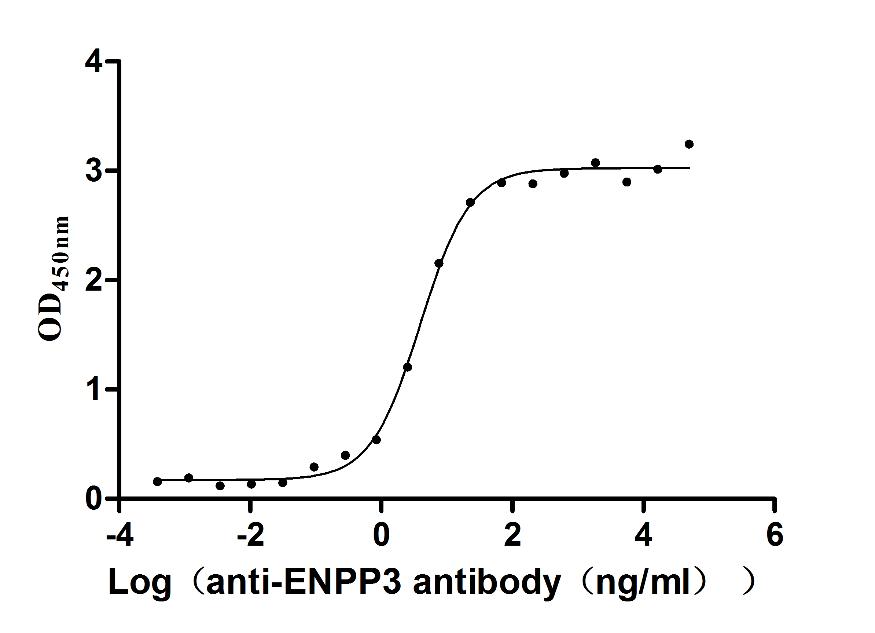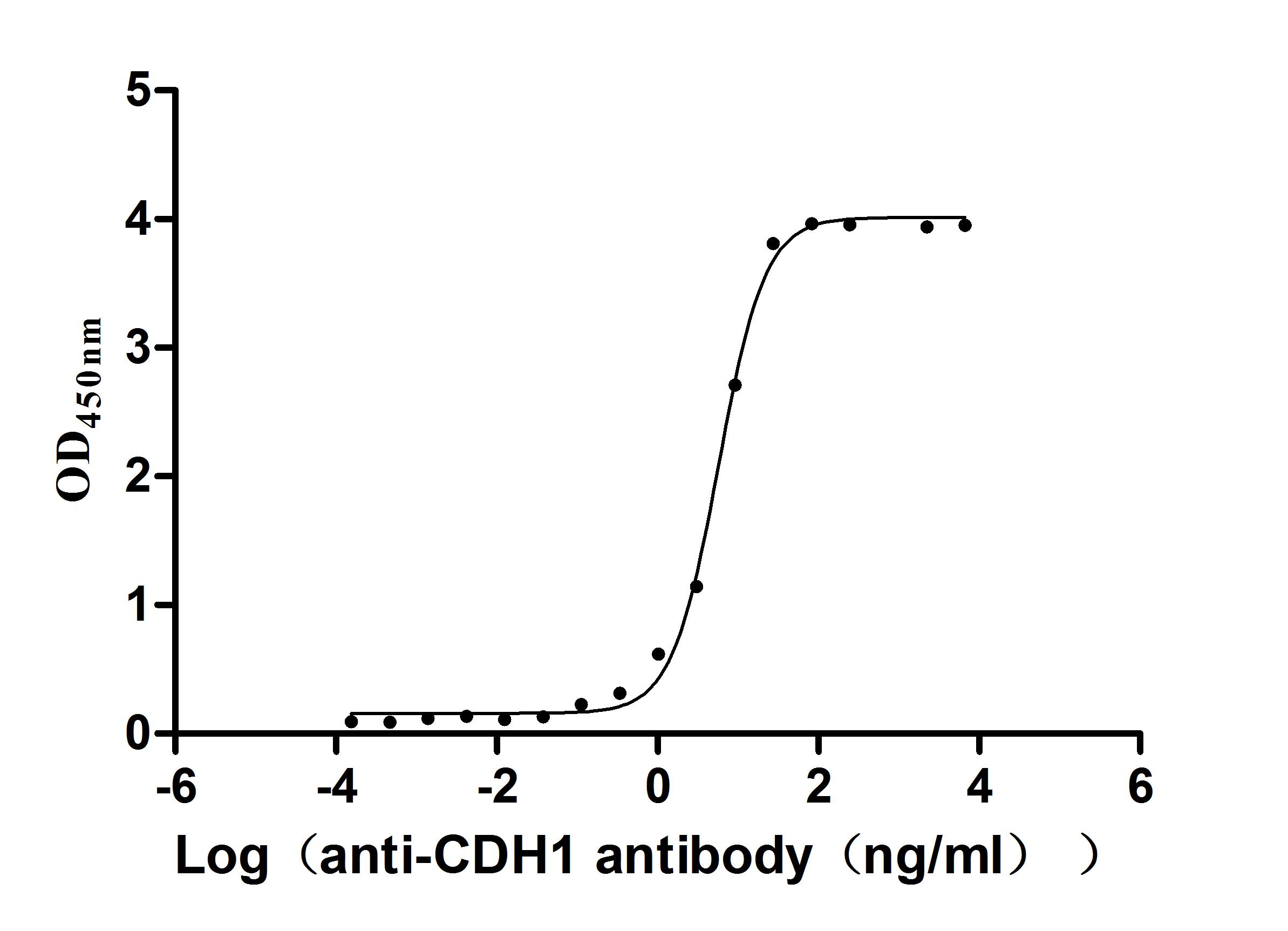Recombinant Human Epsilon-sarcoglycan (SGCE), partial
-
货号:CSB-YP021185HU1
-
规格:
-
来源:Yeast
-
其他:
-
货号:CSB-EP021185HU1
-
规格:
-
来源:E.coli
-
其他:
-
货号:CSB-EP021185HU1-B
-
规格:
-
来源:E.coli
-
共轭:Avi-tag Biotinylated
E. coli biotin ligase (BirA) is highly specific in covalently attaching biotin to the 15 amino acid AviTag peptide. This recombinant protein was biotinylated in vivo by AviTag-BirA technology, which method is BriA catalyzes amide linkage between the biotin and the specific lysine of the AviTag.
-
其他:
-
货号:CSB-BP021185HU1
-
规格:
-
来源:Baculovirus
-
其他:
-
货号:CSB-MP021185HU1
-
规格:
-
来源:Mammalian cell
-
其他:
产品详情
-
纯度:>85% (SDS-PAGE)
-
基因名:SGCE
-
Uniprot No.:
-
别名:SGCE; ESG; UNQ433/PRO840; Epsilon-sarcoglycan; Epsilon-SG
-
种属:Homo sapiens (Human)
-
蛋白长度:Partial
-
蛋白标签:Tag type will be determined during the manufacturing process.
The tag type will be determined during production process. If you have specified tag type, please tell us and we will develop the specified tag preferentially. -
产品提供形式:Lyophilized powder
Note: We will preferentially ship the format that we have in stock, however, if you have any special requirement for the format, please remark your requirement when placing the order, we will prepare according to your demand. -
复溶:We recommend that this vial be briefly centrifuged prior to opening to bring the contents to the bottom. Please reconstitute protein in deionized sterile water to a concentration of 0.1-1.0 mg/mL.We recommend to add 5-50% of glycerol (final concentration) and aliquot for long-term storage at -20℃/-80℃. Our default final concentration of glycerol is 50%. Customers could use it as reference.
-
储存条件:Store at -20°C/-80°C upon receipt, aliquoting is necessary for mutiple use. Avoid repeated freeze-thaw cycles.
-
保质期:The shelf life is related to many factors, storage state, buffer ingredients, storage temperature and the stability of the protein itself.
Generally, the shelf life of liquid form is 6 months at -20°C/-80°C. The shelf life of lyophilized form is 12 months at -20°C/-80°C. -
货期:Delivery time may differ from different purchasing way or location, please kindly consult your local distributors for specific delivery time.Note: All of our proteins are default shipped with normal blue ice packs, if you request to ship with dry ice, please communicate with us in advance and extra fees will be charged.
-
注意事项:Repeated freezing and thawing is not recommended. Store working aliquots at 4°C for up to one week.
-
Datasheet :Please contact us to get it.
相关产品
靶点详情
-
功能:Component of the sarcoglycan complex, a subcomplex of the dystrophin-glycoprotein complex which forms a link between the F-actin cytoskeleton and the extracellular matrix.
-
基因功能参考文献:
- The characterization of iPSC-derived cortical neurons with mutations in SGCE revealed that these cells are a suitable model mirroring the endogenous environment in the myoclonus-dystonia patient brain, especially, when focusing on concrete molecular aspects of the disease mechanism. PMID: 28155872
- A novel nonsense SGCE mutation was found in a Japanese family with myoclonus-dystonia. PMID: 28707723
- This study demonstrated that Psychiatric features are not likely to be related with the SGCE mutation itself but just bespeak disability in clinical MD syndrome regardless of the SGCE mutation. PMID: 28690014
- SGCE mutation can cause a broad range of clinical symptoms between and within families. We should consider MDS as a differential diagnosis for patients with paroxysmal walking abnormalities and/or myoclonic movements. PMID: 25868953
- Tata confirms that SGCE mutations are most commonly identified in Myoclonus dystonia syndrome patients with (1) age at onset
- found one patient with a novel heterozygous frameshift mutation in the DYT11 gene PMID: 25150291
- The co-occurrence of seizures and myoclonus-dystonia suggests that they are both due to the same underlying SGCE mutation PMID: 24297365
- A novel frameshift mutation of the SGCE gene in an Iranian family with Myoclonus-dystonia syndrome confirming the variability of the clinical symptoms caused by the same mutation within members of a family. PMID: 25034659
- In myoclonus-dystonia syndrome patients a substantial mutation in exon 3 of SGCE gene was found. PMID: 23561547
- The results of this study suggested performing gene dosage analysis by multiple ligation-dependent probe amplification (MLPA) to individuate large SGCE deletions that can be responsible for complex phenotypes. PMID: 23677909
- SGCE mutations are associated with a specific psychiatric phenotype consisting of compulsivity, anxiety and alcoholism in addition to the characteristic motor phenotype. PMID: 23365103
- Although reduced penetrance in DYT11-MD has been attributed to the maternal imprinting epsilon-sarcoglycan mutations, NM-DYT11 carriers showed significant metabolic abnormalities that are not explained by this genetic model. PMID: 23284065
- anxiety disorders and executive dysfunctions may be part of the phenotype of myoclonus-dystonia patients with a DYT11 mutation PMID: 22626943
- The results of this review confirmed the association of epsilon-sarcoglycan gene mutations with psychiatric disease and suggest a possible separation of the motor and psychiatric effects. PMID: 21713999
- This report presents a novel mutation in the SGCE gene causing myoclonus dystonia and extends the phenotype of myoclonus dystonia to also include alcohol-induced dystonia. PMID: 22026499
- Dystonia severity in twenty-five clinically affected DYT11 mutation carriers is strongly correlated with increased gray matter volume in bilateral putamina. PMID: 21219543
- This study demonistrated that Familial 7q21.3 microdeletion involving epsilon-sarcoglycan causing myoclonus dystonia, cognitive impairment, and psychosis. PMID: 21425342
- the mRNA expression level of SGCE were significantly up-regulated in tumorous liver tissues compared with corresponding nontumorous counterparts PMID: 21767414
- This study provides the first neurophysiological evidence of cerebellar dysfunction in DYT11 dystonia and supports a role of cerebellar dysfunction in the myoclonus-dystonia phenotype. PMID: 21386109
- Biased SGCE gene expression is based on parent of origin rather than on a strictly dichotomous maternal imprinting mechanism, consistent with clinical observations. PMID: 21320983
- loss of function of the brain-specific SGCE isoform underlies the exclusively neurological myoclonus-dystonia phenotype PMID: 21157498
- Bilateral deep brain stimulation of the internal pallidum proves to be safe and highly effective therapy in a homogeneous population of patients with myoclonus-dystonia due to genetically proved epsilon-sarcoglycan deficiency. PMID: 21220679
- This study identified three novel mutations of SGCE in the respective three myoclonus-dystonia syndrome families in Taiwan. PMID: 20800530
- MMP-7 and SGCE are distinctive molecular factors in sporadic colorectal cancers from the mutator phenotype pathway PMID: 20372795
- Evidence that paternal expression of the epsilon-sarcoglycan gene accounts for reduced penetrance in myoclonus-dystonia PMID: 12444570
- Physiology and surgical response for a 63-year-old woman who underwent deep brain stimulation for myoclonus dystonia related to a SGCE mutation. PMID: 19896264
- 33 month old girl & her twin brother presenting myoclonus on intentional tasks; family history was positive for paternal uncle, his 2 daughters & paternal great grandfather; sequencing revealed a novel nonsense mutation c.942C>A (p.Tyr314X) in exon 7. PMID: 19147379
- Myoclonus-dystonia syndrome: epsilon-sarcoglycan mutations and phenotype PMID: 12325078
- Myoclonus-dystonia is a movement disorder associated with mutations in the epsilon-sarcoglycan gene (SGCE) in most families and in the DRD2 and DYT1 genes in two single families. PMID: 12402271
- placental transcription from SGCE remained unchanged throughout pregnancy PMID: 12620933
- Severe myoclonus-dystonia syndrome characterized by obsessive-compulsive disorder, depression, and anxiety was shown to be associated with a novel truncating mutation located within exon 4 of SGCE. PMID: 12707948
- Genetic analysis of a 5-generation Dutch family with inherited myoclonus-dystonia revealed a 1-bp insertion (885Tins)in exon 7 of the SGCE gene, resulting in frameshift and subsequent protein truncation at amino acid 297. PMID: 12821748
- We describe 3 children with a similar clinical picture of autosomal dominant M-D and an SGCE mutation in only one of them, suggesting that M-D is genetically heterogeneous. PMID: 14978685
- Mutatoins sarse not sassociaatd with sporadic Gilles de la Tourette syndrome. PMID: 15627203
- 3 new mutations were found in patients with essential myoclous or myoclonic dystonia:R372X, 564-576del, IVS3-3T>C. PMID: 15728306
- onset with both myoclonus and dystonia, and axial dystonia were detected significantly more often in the epsilon-sarcoplycan mutation carriers. PMID: 16534121
- Some Myoclonus-dystonia syndrome-associated mutations in SGCE impair trafficking of the mutant protein to the plasma membrane. PMID: 17200151
- a heterozygous point mutation in the epsilon-sarcoglycan gene, which leads to skipping of exon 5 in a family with myoclonus-dystonia syndrome complicated with severe depression PMID: 17230465
- Obsessive-compulsive disorder and alcohol dependence are associated with manifesting mutated SGCE. PMID: 17296918
- Our findings are not sufficient to conclude whether different SGCE mutations could lead to different phenoytpes of myoclonus-dystonia. PMID: 17394244
- Korean Myoclonus-dystonia syndrome family with a novel splicing mutation of the SGCE gene and a unique phenotype mimicking Moya-Moya disease. PMID: 17394247
- Autosomal dominant myoclonus-dystonia and Tourette syndrome in a family without linkage to the SGCE gene. PMID: 17702041
- Two additional patients carried a de novo SGCE nonsense mutation in exon 3 (R97X) and a novel SGCE missense mutation in exon 6 (G227V) in this study. PMID: 17702043
- Genomic deletion size at the epsilon-sarcoglycan locus determines the clinical phenotype in myoclonus-dystonia. PMID: 17898012
- intragenic deletions with SGCE and it highlights the need to include exonic copy number variation when performing mutational analysis of SGCE. PMID: 18098280
- Real-time PCR showed that ETOH significantly altered the expression of genes involved in cell adhesion. There was an increase in the expression of alpha and beta Laminins 1, beta Integrins 3 and 5, Secreted phosphoprotein1 and Sarcoglycan epsilon. PMID: 18162078
- Myoclonus-dystonia due to SGCE protein mutations is characterized by early onset myoclonic jerks, often associated with dystonia. PMID: 18175340
- Two heterozygous deletions of the entire SGCE gene and flanking DNA and a heterozygous deletion of exon 2 only were detected, accounting for 33% (3/9) of the mutations found. PMID: 18205193
- There was no association of the SCGE coding & flanking intronic region in OCD and/or GTS or CMT. The functional relevance of a newly found c.1314+172T>C 3'-untranslated region variant has yet to be determined. PMID: 18349702
- No muscle involvement in myoclonus-dystonia caused by epsilon-sarcoglycan gene mutations. PMID: 18355305
显示更多
收起更多
-
相关疾病:Dystonia 11, myoclonic (DYT11)
-
亚细胞定位:Cell membrane, sarcolemma; Single-pass membrane protein. Cytoplasm, cytoskeleton. Cell projection, dendrite. Golgi apparatus.
-
蛋白家族:Sarcoglycan alpha/epsilon family
-
组织特异性:Ubiquitous.
-
数据库链接:
HGNC: 10808
OMIM: 159900
KEGG: hsa:8910
UniGene: Hs.371199
Most popular with customers
-
Recombinant Human C5a anaphylatoxin chemotactic receptor 1 (C5AR1)-VLPs (Active)
Express system: Mammalian cell
Species: Homo sapiens (Human)
-
Recombinant Mouse Retinol-binding protein 4 (Rbp4) (Active)
Express system: Mammalian cell
Species: Mus musculus (Mouse)
-
Express system: Mammalian cell
Species: Macaca fascicularis (Crab-eating macaque) (Cynomolgus monkey)
-
Recombinant Human Epithelial discoidin domain-containing receptor 1 (DDR1), partial (Active)
Express system: Mammalian cell
Species: Homo sapiens (Human)
-
Recombinant Human Desmoglein-3 (DSG3), partial (Active)
Express system: Baculovirus
Species: Homo sapiens (Human)
-
Recombinant Human Myosin regulatory light polypeptide 9 (MYL9) (Active)
Express system: Yeast
Species: Homo sapiens (Human)
-
Recombinant Human Myosin regulatory light chain 12B(MYL12B) (Active)
Express system: E.coli
Species: Homo sapiens (Human)
-
Recombinant Human Cadherin-1(CDH1),partial (Active)
Express system: Mammalian cell
Species: Homo sapiens (Human)




















